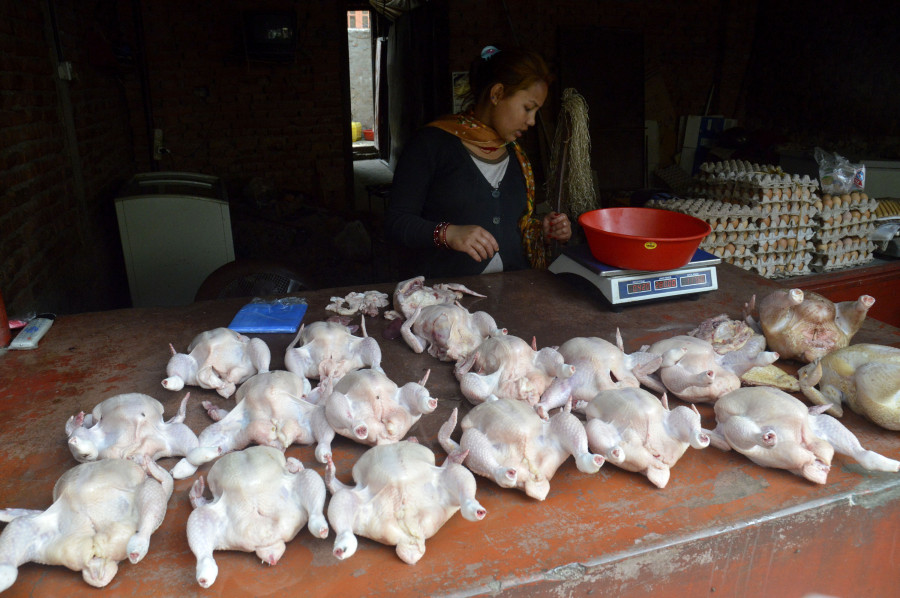Money
Meat sales, and price, shoot up despite occurrence of holy month
Traders said the traditional meat-free month could have been disregarded due to the lunar eclipse.
Krishana Prasain
Sales of meat products usually take a hit during the month of Shrawan because people undergo fasts as part of religious observances. But this year, the situation has reversed.
Meat prices have reached a record high, and may increase further because demand has been higher than at other times. Livestock retailers and associations said that the price of mutton had touched a record Rs1,300 per kg in the Kathmandu Valley.
Most people avoid non-vegetarian food especially on Monday or 'sawan ko sombar', but soaring sales show that this is no longer the case. Traders said the traditional meat-free month could have been disregarded due to the lunar eclipse which lasted till the morning of July 17, the first day of Shrawan.
Chicken prices reached Rs350 per kg this week. Eggs have become dearer by Rs60 per crate. Chicken prices rose to a high of Rs400 per kg in November 2014 due to shortages after the government culled thousands of live birds following a bird flu outbreak.
Dipak Thapa, former president of the Livestock Traders Association, said that the price of mutton had jumped to a record high as imports of livestock from India dropped 50 percent after the government made it mandatory for traders to produce a quarantine certificate while bringing live goats from the southern neighbour. He said that demand for meat had been growing as well.
Indian authorities have also made it compulsory for traders to obtain a certificate before exporting livestock to Nepal.
“Goat imports are down to almost zero. As a result, the market has witnessed a short supply that has triggered a massive price rice in the Kathmandu Valley which is the largest consumer.” Until last month, the price of live goat was Rs540 per kg, and now it costs Rs700 per kg, he said.
Prem Bahadur Shrestha, owner of Prem Fresh Meat Shop at Sinamangal, told the Post that he had been selling mutton at Rs1,300 and chicken at Rs350 from last week.
“Meat prices never increased during the mid-June to mid-August period in past years, but this year the situation is different,” said Anil Khadgi, former vice-chairman of the Nepal Fish and Meat Sellers Association. According to the association, the Kathmandu Valley consumes around 90 tonnes of mutton daily.
Nepal is self-sufficient in chicken meat, the most popular meat in the valley. Even then, prices have risen sharply. Traders attributed the rise in prices to lowered production.
Rishi Ram Paudel, president of the Nepal Livestock Entrepreneurs Forum, said that prices of chicken and eggs had increased due to low domestic production. Output has fallen by 50 percent, he said. “It was largely due to the bird flu issue during the period mid-February to mid-April.”
Yogendra Gauchan, director general of the Department of Supply Management and Protection of Consumer Interest, told the Post that a shortage of goats and chicken appeared due to floods and landslides in many districts in the Tarai.
He said that there were complaints that traders had been engaged in artificial price hikes taking advantage of the quarantine issue at the border. “We have decided to monitor the market more aggressively this week following the unnatural price hike.”
He added that the government did not fix the price of every essential product, and the market determines prices under the open market policy. “But we regularly monitor the market to check whether the prices are reasonable or not.”
Chandra Dhakal, information officer at the Department of Livestock Services, said imports had slowed after the government made it mandatory for traders to produce a quarantine certificate while importing live goats from the southern neighbour.
According to him, the government has also started charging 5 percent customs duty on livestock imported from India which has made meat dearer in the domestic market.
Makwanpur, Dang, Nuwakot and Sindhupalchok districts are the main sources of live goats for the valley. Imported live goats mainly come from Uttar Pradesh state of India.
Government statistics show that Nepal’s annual per capita meat consumption is 12 kg. The government aims to increase it to 14 kg per person. Meat consumption per person was 9.8 kg in 2008 and 9.7 kg in 2000. Nepal has a long way to go to achieve self-sufficiency in goat meat production.
***
What do you think?
Dear reader, we’d like to hear from you. We regularly publish letters to the editor on contemporary issues or direct responses to something the Post has recently published. Please send your letters to [email protected] with "Letter to the Editor" in the subject line. Please include your name, location, and a contact address so one of our editors can reach out to you.




 15.12°C Kathmandu
15.12°C Kathmandu














